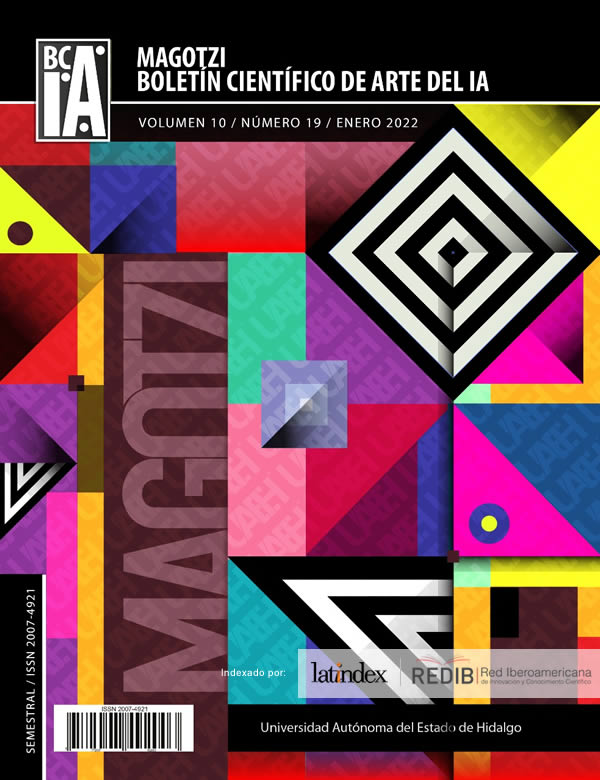Fibras, telas e hilos, vistos desde el arte
DOI:
https://doi.org/10.29057/ia.v10i19.7879Palabras clave:
Bordado, arte contemporáneo, arte textilResumen
A partir del siglo XX el arte ha tenido un cambio, ya que no sólo se ha conformado con el desarrollo de las técnicas clásicas tradicionales atribuidas a las bellas artes. En su búsqueda, las y los artistas, han transgredido el uso de los materiales, de los formatos y de los soportes. Actualmente es posible encontrar un numeroso grupo de obras que son el resultado de haber retomado una disciplina ancestral, nos referimos al uso del tejido y el bordado para crear un nuevo arte, llevándolo a las galerías, a los museos y a espacios abiertos para darle un sentido que va más allá de la tradición. En este nuevo tipo de prácticas destacan las esculturas o las instalaciones de Sheila Hicks, Francoise Grossen y Ewa Jarosznska, entre otros. Estos autores utilizan diferentes tipos de fibras naturales para crear este tipo de arte textil, el cual, también es conocido hoy en día como Fiber art. Con el desarrollo de la presente investigación, se observó que artistas contemporáneos han seguido los pasos de los primeros artistas precursores en el uso de hilos, fibras y telas en el arte, y con ello han logrado una mayor apertura para que los textiles ya no sean vistos únicamente como un arte menor o artesanía.
Descargas
Información de Publicación
Perfiles de revisores N/D
Declaraciones del autor
Indexado en
- Sociedad académica
- N/D
Citas
Angulo, A., & Martìnez, M. M. (2016). El mensaje esta en el tejido. México: Futura Textos.
Blanca, R. M. (2014). El bordado en lo cotidiano y en el arte contemporáneo. Feminismo, 2(3), 1-13. Obtenido de www.feminismos.neim.ufba.br
Bondía Fernández, C. (2014). Artes textiles en el 2012. Nuevas tendencias en el arte textil contemporáneo preservación , material y conceptual, Museo Reyna Sofía, 254.
Corral, R. (2015). Batik- arte textil milenario. Arte y sociedad. Revista de Investigación (8), 1-9.
De la Colina Tejada, L., & Chinchón Espino, A. (2012). El empleo del textil en el arte: aproximaciones a una taxonmía. Espacio, Tiempo y Forma. Serie V, T.4, 179-194. Madrid: Universidad Nacional de Educación a Distancia.
Elderton, L., & Morrill, R. (2019). Vitamina T, Threads & Textiles. Nueva York: Phaidon.
Guasch, A. (2000). El arte ultimo del siglo XX. Madrid: Alianza Forma.
Heidegger, M. (1992). El origen de la obra de Arte en Arte y Poesia. FCE.
Leonis, D. (2013). La producción Textil como actividad doméstica de los cazadores-recolectores prehispanicos en la región Pampeana, Arg. Intersecciones de Antropología, 16(1), 131-144. Obtenido de http://www.scielo.org.ar/scielo.php?script=sci_arttext&pid=S1850-373X2015000100008
Rodríguez Peinado, L. (2003). El textil en la antigüedad y la Alta Edad Media. Madrid: Facultad
Sierzputowski, Kate. (14 de Enero de 2019). Colossal. Obtenido de Materiales de alfombra Deadstock Transformados en un jardiín de coral inmersivo por Vanessa Barragao: https://www.thisiscolossal.com/2019/01/coral-garden-by-vanessa-barragao/
Staugaitis, L. (7 de Junio de 2019). Colossal. Obtenido de Las instalaciones texturales de Shoplifter sumergen a los visitantes en las cuevas de neón: https://www.thisiscolosal.com/2019/06/shoplifter/
Simón, M. F. (2008). Fibras 09. Arte textil contemporáneo. Madrid: Caja Madrid.
Tobon, P, et. (2001). Del arte objetual al arte de concepto,Epiologo sobre la sensibilidad posmoderna. Madrid: Akal.
Yllades, M. E. (2015). El textil: del mito del origen a la era multimedia. El textil: del mito del origen a la era multimedia, 371. Valencia, España: Universidad Politécnica de Valencia. Recuperado el 8 de junio de 2017, de https/riunet.upv.es/bitstream/handle/10251/57488/YLLADES%20-%20El%20textil%34



















